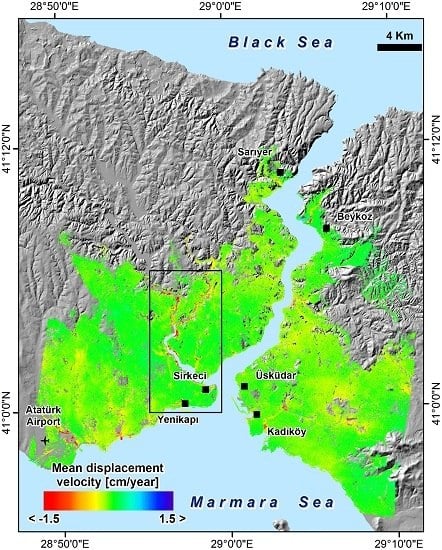The Space-Borne SBAS-DInSAR Technique as a Supporting Tool for Sustainable Urban Policies: The Case of Istanbul Megacity, Turkey
Abstract
:1. Introduction
2. Study Area: Istanbul Megacity
2.1. Urbanization and its Impact on Land
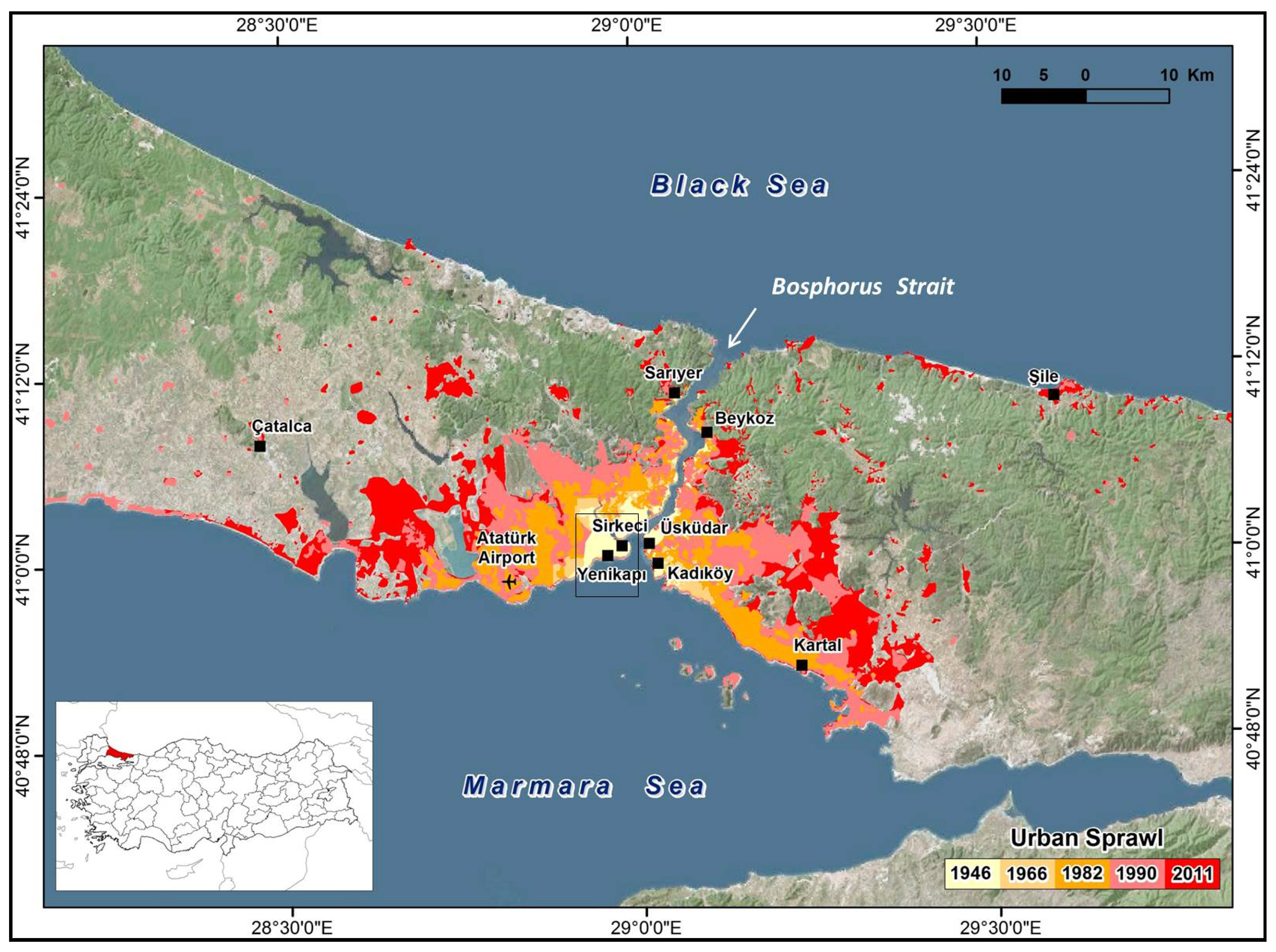

2.2. Geological Setting
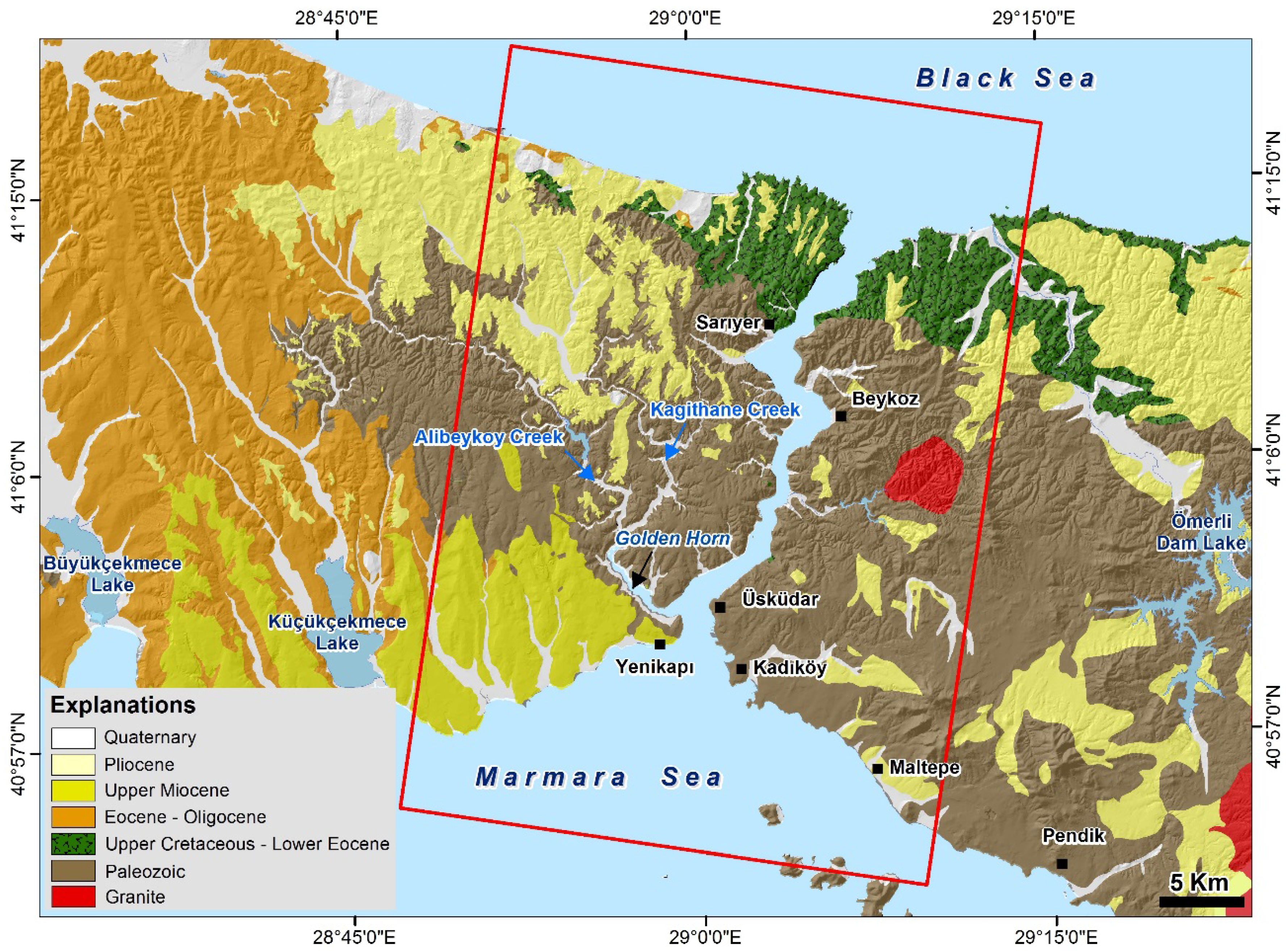
3. Data and Method
3.1. The SBAS-DInSAR Technique
3.2. SAR Data Processing
4. Results
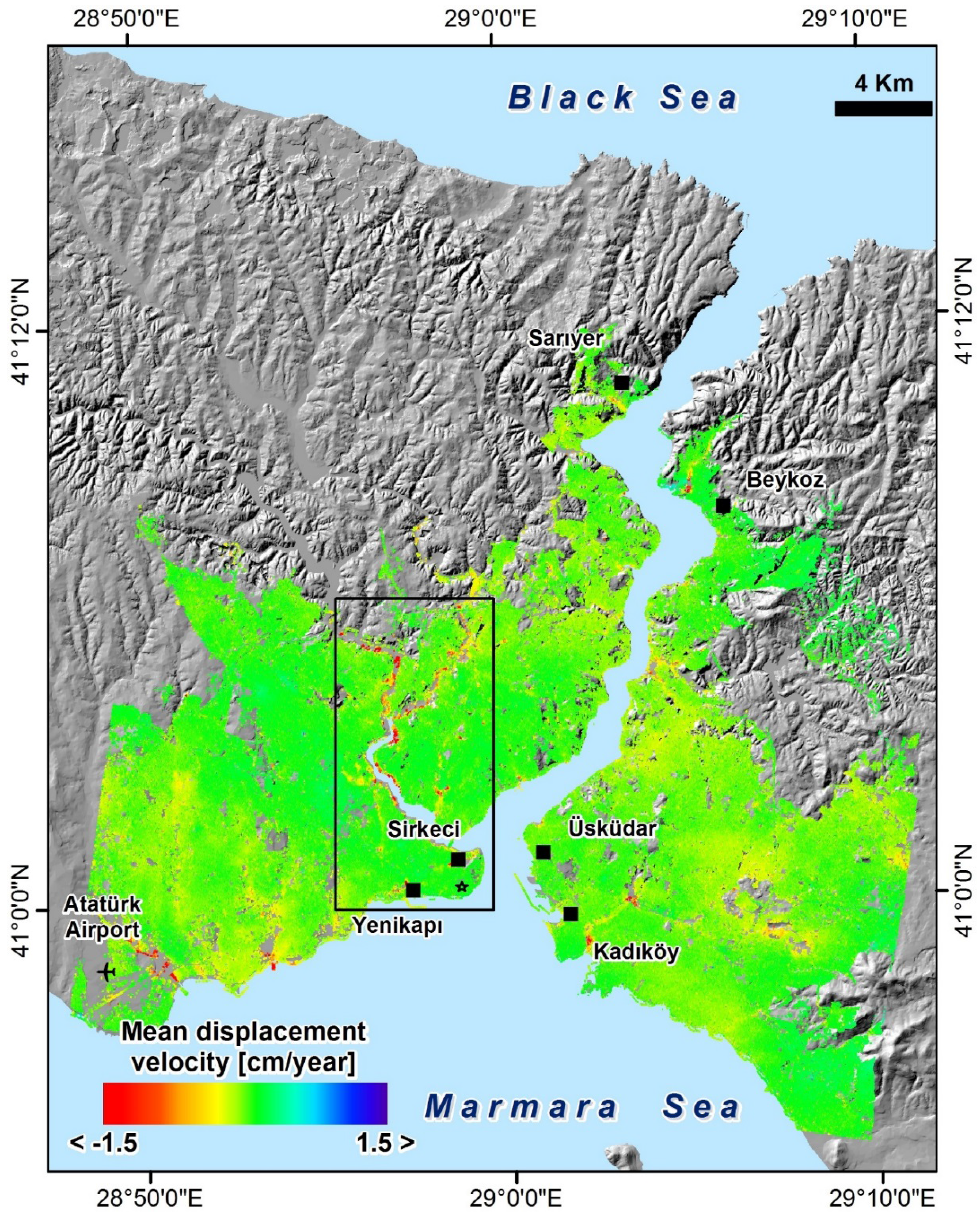
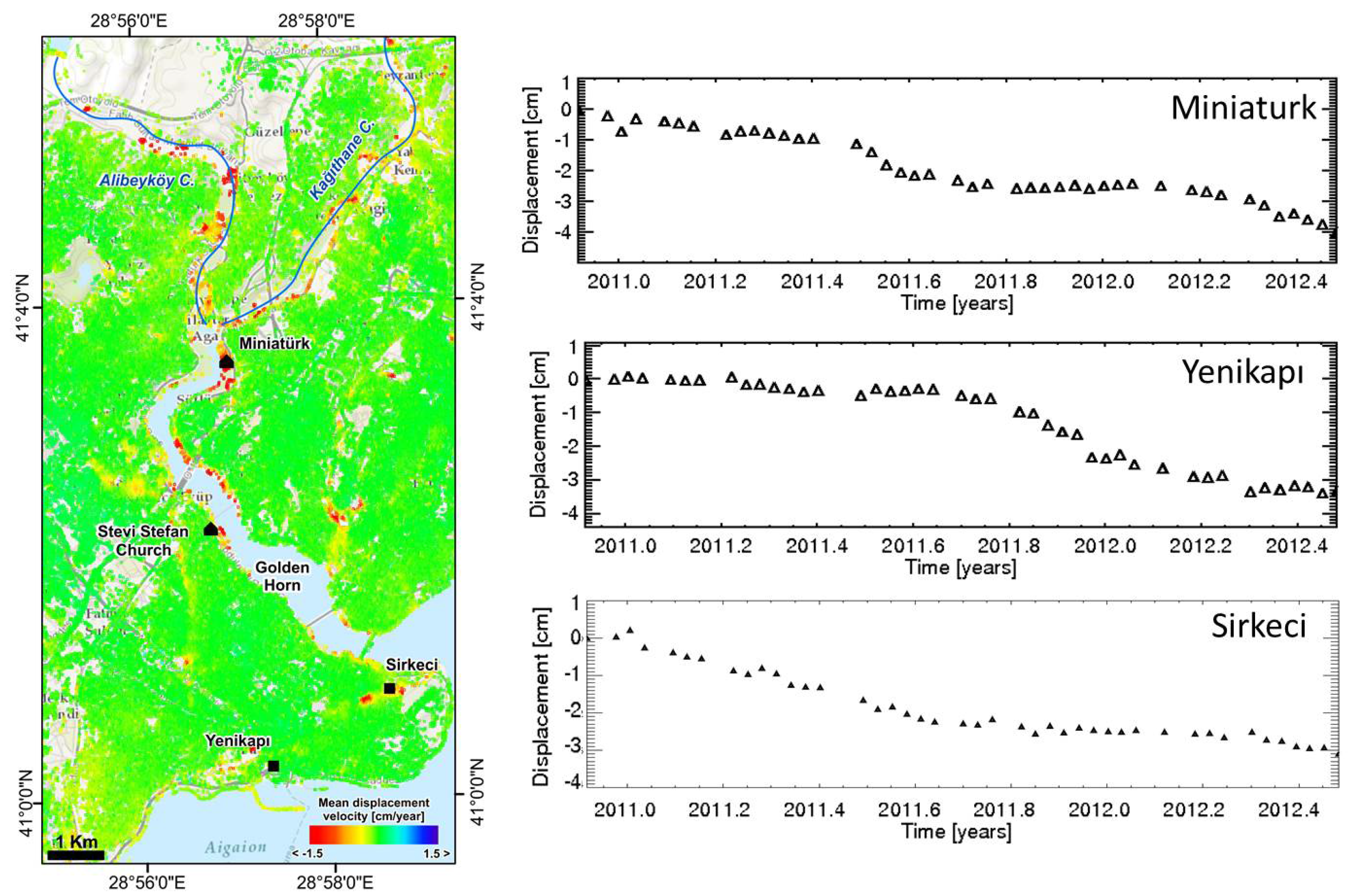
5. Discussion

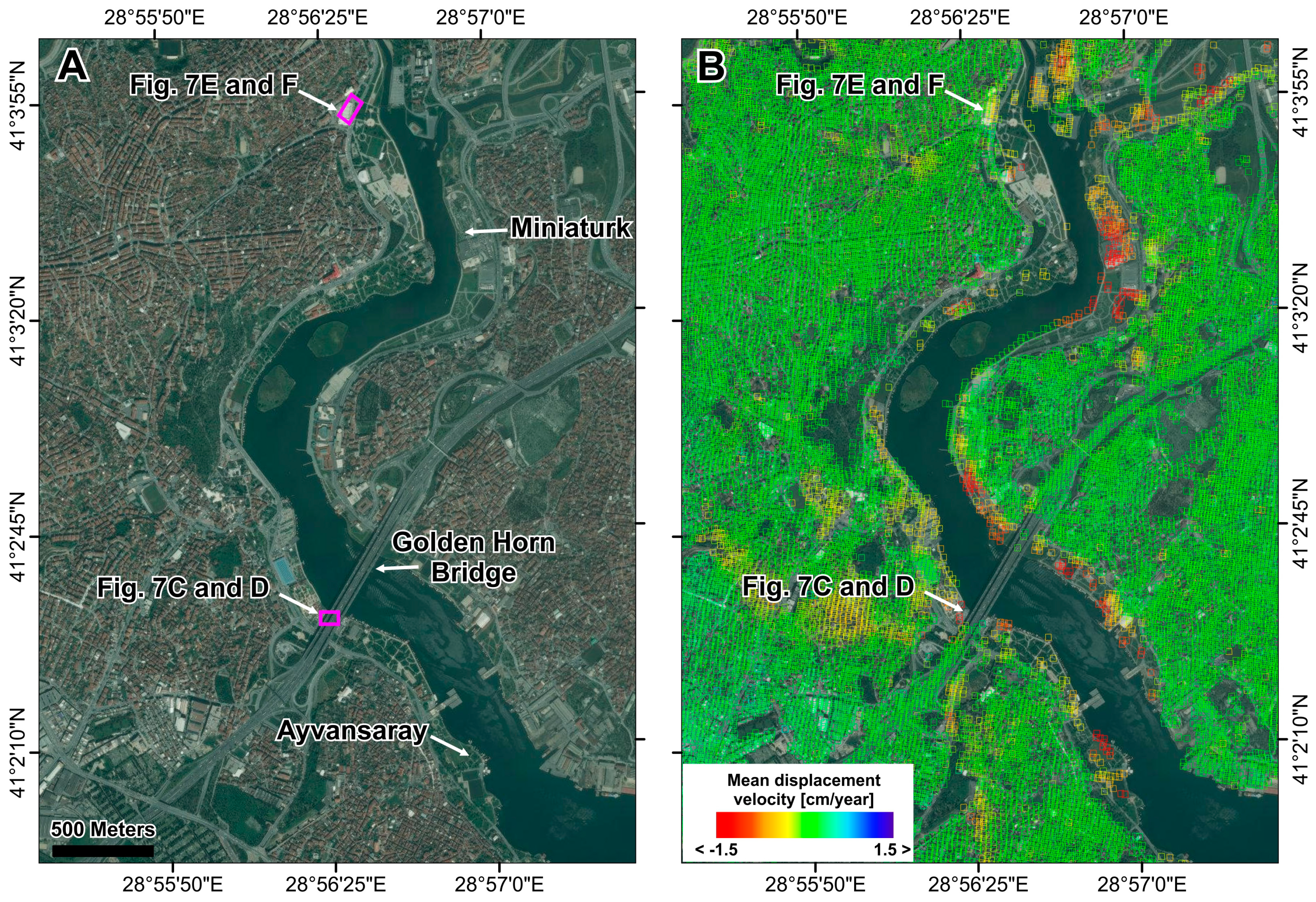
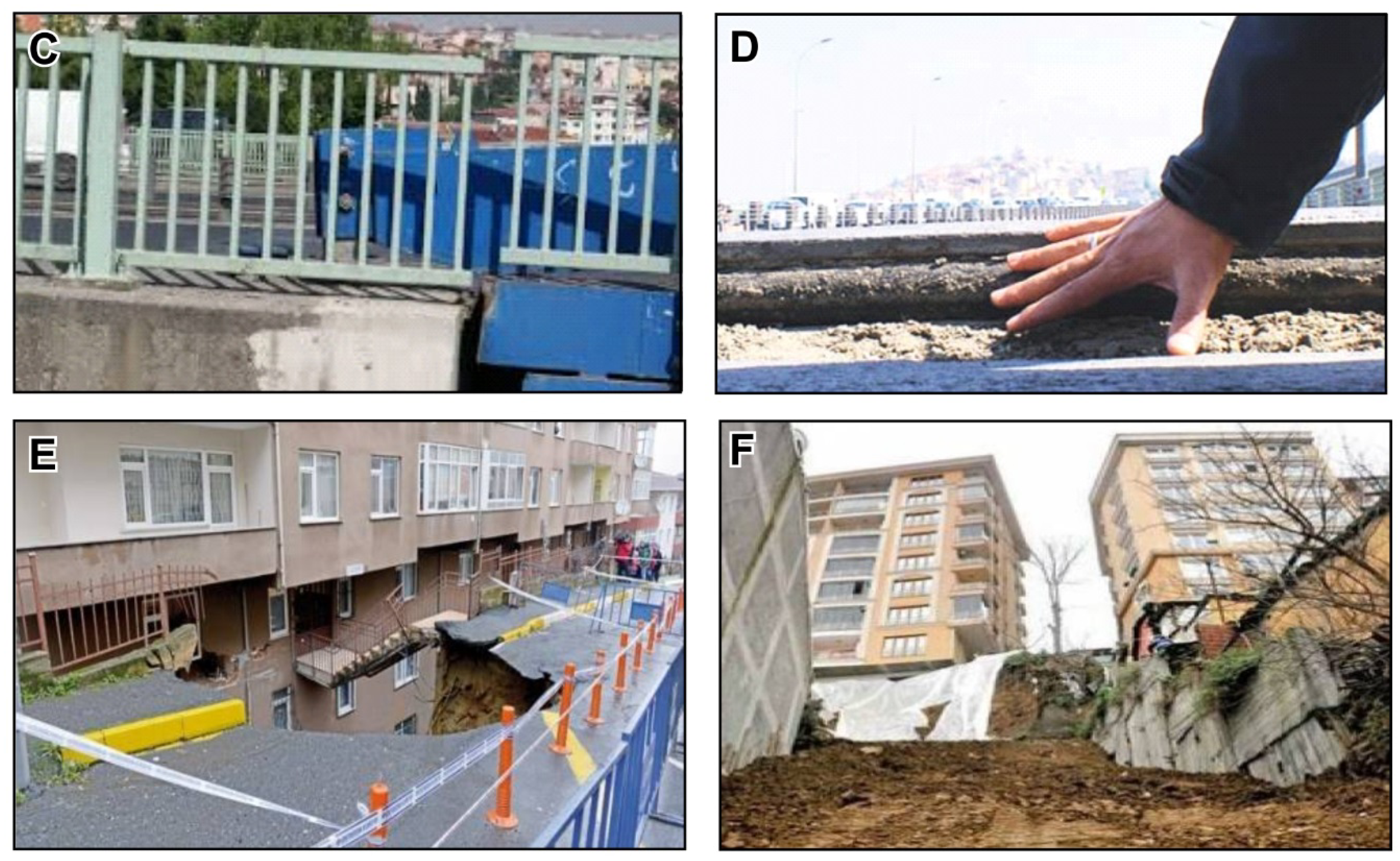
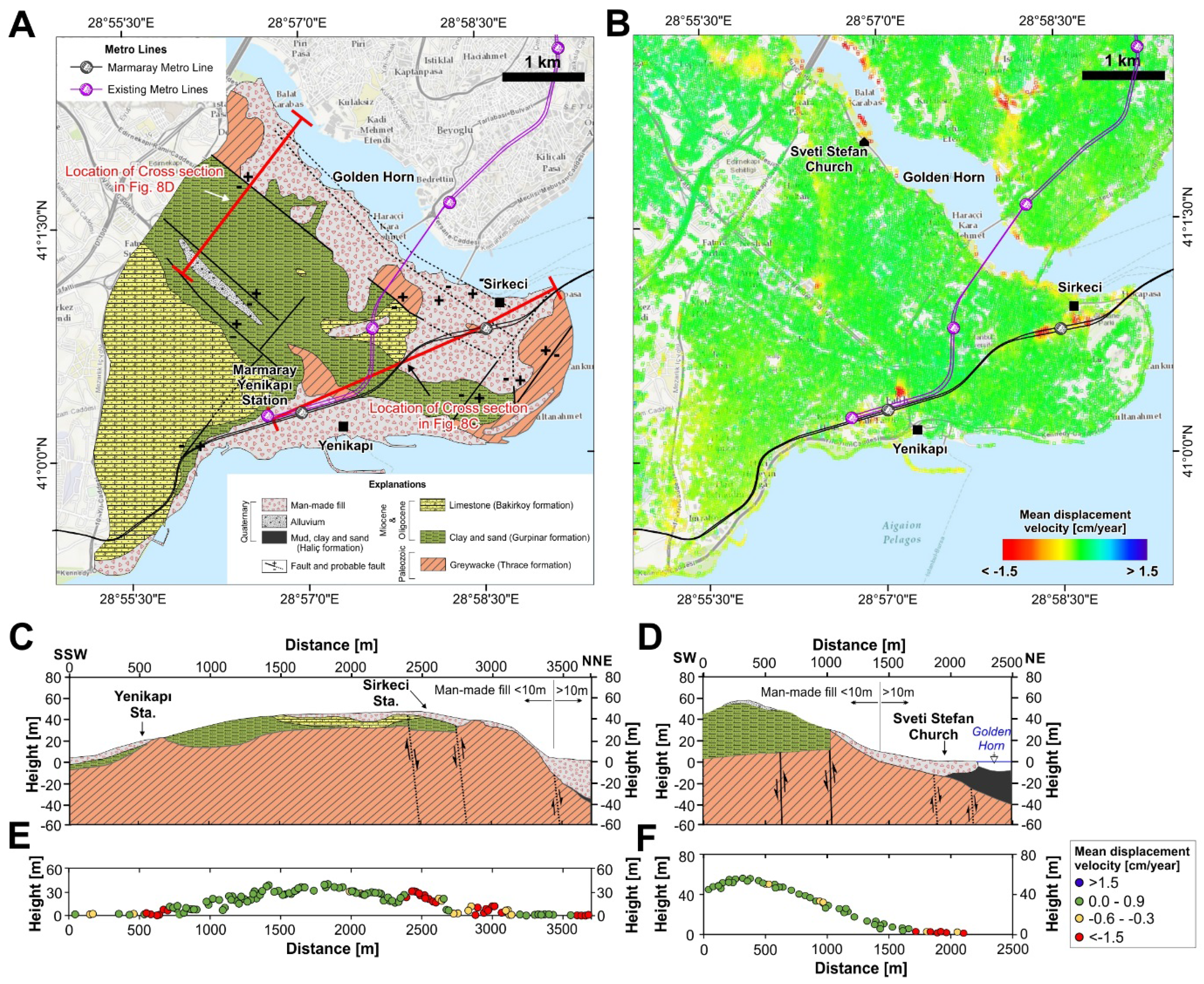

6. Conclusions
Acknowledgments
Author Contributions
Conflicts of Interest
References
- Kraas, F.; Aggarwal, S.; Coy, M.; Mertins, G. (Eds.) Megacities—Our Global Urban Future, 1st ed.; Springer: Dordrecht, The Netherlands, 2014; p. 225.
- United Nations, Department of Economic and Social Affairs, Population Division. World Urbanization Prospects: The 2014 Revision, Highlights (ST/ESA/SER.A/352), 2014. Available online: http://esa.un.org/unpd/wup/Highlights/WUP2014-Highlights.pdf (accessed on 3 September 2015).
- Kraas, F.; Mertins, G. Megacities and global changes. In Megacities—Our Global Urban Future, 1st ed.; Kraas, F., Aggarwal, S., Coy, M., Mertins, G., Eds.; Springer: Dordrecht, The Netherlands, 2014; pp. 1–6. [Google Scholar]
- Narang Suri, S.; Taube, G. Governance in megacities: Experiences, challenges and implications for international cooperation. In Megacities—Our Global Urban Future, 1st ed.; Kraas, F., Aggarwal, S., Coy, M., Mertins, G., Eds.; Springer: Dordrecht, The Netherlands, 2014; pp. 195–200. [Google Scholar]
- Marsal-Llacuna, M.-L.; Colomer-Llinàs, J.; Meléndez-Fri, J. Lessons in urban monitoring taken from sustainable and livable cities to better address the Smart Cities initiative. Technol. Forecast. Soc. Chang. 2015, 90, 611–622. [Google Scholar] [CrossRef]
- Goli, S.; Arokiasamy, P.; Chattopadhayay, A. Living and health conditions of selected cities in India: Setting priorities for the National Urban Health Mission. Cities 2011, 28, 461–469. [Google Scholar] [CrossRef]
- Alpkokin, P.; Ergun, M. Istanbul Metrobüs: First intercontinental bus rapid transit. J. Transp. Geogr. 2012, 24, 58–66. [Google Scholar] [CrossRef]
- McIntyre, N.E.; Knowles-Yànez, K.; Hope, D. Urban ecology as an interdisciplinary field: Differences in the use of “urban” between the social and natural sciences. Urban Ecosyst. 2000, 4, 5–24. [Google Scholar] [CrossRef]
- Atmis, E.; Ozden, S.; Lisec, W. Urbanization pressures on the natural forests in Turkey: An overview. Urban For.Urban Green. 2007, 6, 83–92. [Google Scholar] [CrossRef]
- Hossain, F.; Degu, A.M.; Woldemichael, A.T.; Yigzaw, W.; Mitra, C.; Shepherd, J.M.; Siddique-E-Akbor, A.H.M. Water resources vulnerability in the context of rapid urbanization of Dhaka City (a South Asian megacity). In Climate Vulnerability; Pielke, R.A., Ed.; Academic Press: Oxford, UK, 2013; pp. 393–404. [Google Scholar]
- Smyth, C.G.; Royle, S.A. Urban landslide hazards: incidence and causative factors in Niterói, Rio de Janeiro State, Brazil. Appl. Geogr. 2000, 20, 95–118. [Google Scholar] [CrossRef]
- Geymen, A.; Baz, I. The potential of remote sensing for monitoring land cover changes and effects on physical geography in the area of Kayisdagi Mountain and its surroundings (Istanbul). Environ. Monit. Assess. 2008, 140, 33–42. [Google Scholar] [CrossRef] [PubMed]
- Gencer, E.A. The Interplay between urban development, vulnerability, and risk management. A case study of the Istanbul metropolitan area. Mediter. Stud. 2013, 7. [Google Scholar] [CrossRef]
- Kerle, N.; Müller, A. Megacities and natural hazards. In Encyclopedia of Natural Hazards; Bobrowsky, P.T., Ed.; Springer: Dordrecht, The Netherlands, 2013; pp. 660–664. [Google Scholar]
- Turkish Statistical Institute. Available online: http://www.turkstat.gov.tr (accessed on 3 September 2015).
- Environmental and Social Impact Assessment for the Eurasia Tunnel Project Istanbul, Turkey. 2011, Volume I. Project No. P0106067; Draft report. Available online: http://www.eib.org/attachments/pipeline/20090678_nts_en.pdf (accessed on 3 September 2015).
- Parsons, T.; Toda, S.; Stein, R.S.; Barka, A.; Dieterich, J.H. Heightened odds of large earthquakes near Istanbul: An interaction-based probability calculation. Science 2000, 288, 661–665. [Google Scholar] [CrossRef] [PubMed]
- Parsons, T. Recalculated probability of M ≥ 7 earthquakes beneath the sea of Marmara, Turkey. J. Geophys. Res. 2004, 109. [Google Scholar] [CrossRef]
- Istanbul, Turkey Disaster Risk Management Profile; 3CD City Profiles Series-Current Working Document: Istanbul, Turkey, 2005; p. 23. Available online: http://www.urban-response.org/resource/7566 (accessed on 3 September 2015).
- Duman, T.Y.; Can, T.; Gokceoglu, C.; Nefeslioglu, H.A.; Sonmez, H. Application of logistic regression for landslide susceptibility zoning of Cekmece Area, Istanbul, Turkey. Environ. Geol. 2006, 51, 241–256. [Google Scholar] [CrossRef]
- Gencer, E.A. Natural Disasters, Vulnerability, and Sustainable Development: Examining the Interplay, Global Trends, and Local Practices in Istanbul; VDM Publishing: Saarbrücken, Germany, 2008; p. 418. [Google Scholar]
- Geohazard Supersites—Group on Earth Observations. Available online: supersites.earthobservations.org (accessed on 3 September 2015).
- Sesetyan, K.; Zulfikar, C.; Demircioglu, M.; Hancilar, U.; Kamer, Y.; Erdik, M. Istanbul Earthquake Rapid Response System: Methods and practices. Soil Dyn. Earthq. Eng. 2011, 31, 170–180. [Google Scholar] [CrossRef]
- Gunes, O. Turkey’s grand challenge: Disaster-Proof building inventory within 20 years. Case Stud. Constr. Mater. 2015. [Google Scholar] [CrossRef]
- World Bank. Building Safer Cities. The Future of Disaster Risk; Kreimer, A., Arnold, M., Carlinne, A., Eds.; The World Bank: Washington, DC, USA, 2003; p. 299. [Google Scholar]
- Huppert, H.E.; Sparks, S. Extreme natural hazards: Population growth, globalization and environmental change. Phil. Trans. R. Soc. A. 2006, 364, 1875–1888. [Google Scholar] [CrossRef] [PubMed]
- Boughedir, S. Case study: Disaster risk management and climate change adaptation in Greater Algiers: Overview on a study assessing urban vulnerabilities to disaster risk and proposing measures for adaptation. Curr. Opin. Environ. Sustain. 2015, 13, 103–108. [Google Scholar] [CrossRef]
- Bürgmann, R.; Rosen, P.A.; Fielding, E.J. Synthetic aperture radar interferometry to measure Earth's surface topography and its deformation. Ann. Rev. Earth Planet. Sci. 2000, 28, 169–209. [Google Scholar] [CrossRef]
- Massonnet, D.; Feigl, K.L. Radar Interferometry and its application to changes in the Earth’s surface. Rev. Geophys. 1998, 36, 441–500. [Google Scholar] [CrossRef]
- Hensley, S.; Farr, T. Microwave remote sensing and surface characterization. In Treatise on Geomorphology—Remote Sensing and GIScience in Geomorphology; Shroder, J., Bishop, M.P., Eds.; Academic Press: San Diego, CA, USA, 2013; Volume 3, pp. 43–79. [Google Scholar]
- Massonnet, D.; Rossi, M.; Carmona, C.; Ardagna, F.; Peltzer, G.; Feigl, K.; Rabaute, T. The displacement field of the Landers earthquake mapped by radar interferometry. Nature 1993, 364, 138–142. [Google Scholar] [CrossRef]
- Massonnet, D.; Briole, P.; Arnaud, A. Deflation of Mount Etna monitored by spaceborne radar interferometry. Nature 1995, 375, 567–570. [Google Scholar] [CrossRef]
- Ferretti, A.; Prati, C.; Rocca, F. Permanent scatterers in SAR interferometry. IEEE Trans. Geosci. Remote Sens. 2001, 39, 8–20. [Google Scholar] [CrossRef]
- Berardino, P.; Fornaro, G.; Lanari, R.; Sansosti, E. A new algorithm for surface deformation monitoring based on small baseline differential SAR interferograms. IEEE Trans. Geosci. Remote Sens. 2002, 40, 2375–2383. [Google Scholar] [CrossRef]
- Mora, O.; Mallorqui, J.J.; Broquetas, A. Linear and nonlinear terrain deformation maps from a reduced set of interferometric SAR images. IEEE Trans. Geosci. Remote Sens. 2003, 41, 2243–2253. [Google Scholar] [CrossRef]
- Werner, C.; Wegmuller, U.; Strozzi, T.; Wiesmann, A. Interferometric point target analysis for deformation mapping. In Proceedings of IEEE International Geoscience and Remote Sensing Symposium, Toulose, France, 21–25 July 2003; pp. 4362–4364.
- Hooper, A. A multi-temporal InSAR method incorporating both persistent scatterer and small baseline approaches. Geophys. Res. Lett. 2008, 35, L16302. [Google Scholar] [CrossRef]
- Zebker, H.A.; Villasenor, J. Decorrelation in interferometric radar echoes. IEEE Trans. Geosci. Remote Sens. 1992, 30, 950–959. [Google Scholar] [CrossRef]
- Lanari, R.; Mora, O.; Manunta, M.; Mallorquì, J.J.; Berardino, P.; Sansosti, E. A small baseline approach for investigating deformation on full resolution differential SAR interferograms. IEEE Trans. Geosci. Remote Sens. 2004, 42, 1377–1386. [Google Scholar] [CrossRef]
- Crosetto, M.; Castillo, M.; Arbiol, R. Urban subsidence monitoring using radar interferometry: Algorithms and validation. Photogramm. Eng. Remote Sens. 2003, 69, 775–783. [Google Scholar] [CrossRef]
- Lanari, R.; Lundgren, P.; Manzo, M.; Pepe, A. Satellite radar interferometry time series analysis of surface deformation for Los Angeles, California. Geophys. Res. Lett. 2004, 31. [Google Scholar] [CrossRef]
- Cascini, L.; Ferlisi, S.; Fornaro, G.; Lanari, R.; Peduto, D.; Zeni, G. Subsidence monitoring in Sarno urban area via multitemporal DInSAR technique. Int. J. Remote Sens. 2006, 27, 1709–1716. [Google Scholar] [CrossRef]
- Lanari, R.; Casu, F.; Manzo, M.; Zeni, G.; Berardino, P.; Manunta, M.; Pepe, A. An overview of the small baseline subset algorithm: A DInSAR technique for surface deformation analysis. Pure Appl. Geophys. 2007, 164, 637–661. [Google Scholar] [CrossRef]
- Stramondo, S.; Saroli, M.; Tolomei, C.; Moro, M.; Doumaz, F.; Pesci, A.; Loddo, F.; Baldi, P.; Boschi, E. Surface movements in Bologna (Po Plain—Italy) detected by multitemporal DInSAR. Remote Sens. Environ. 2007, 110, 304–316. [Google Scholar] [CrossRef]
- Herrera, G.; Fernandez-Merodo, J.; Tomas, R.; Cooksley, G.; Mulas, J. Advanced interpretation of subsidence in Murcia (SE Spain) using A-DInSAR data-modelling and validation. Natural Hazard. Earth Syst. Sci. 2009, 9, 647–661. [Google Scholar] [CrossRef] [Green Version]
- Osmanoglu, B.; Dixon, T.H.; Wdowinski, S.; Cabral-Cano, E.; Jiang, Y. Mexico City subsidence observed with persistent scatterer InSAR. Int. J. Appl. Earth Obs. 2011, 13, 1–12. [Google Scholar] [CrossRef]
- Calò, F.; Calcaterra, D.; Iodice, A.; Parise, M.; Ramondini, M. Assessing the activity of a large landslide in southern Italy by ground-monitoring and SAR interferometric techniques. Int. J. Remote Sens. 2012, 33, 3512–3530. [Google Scholar] [CrossRef]
- Arangio, S.; Calò, F.; Di Mauro, M.; Bonano, M.; Marsella, M. An application of the SBAS-DInSAR technique for the assessment of structural damage in the city of Rome. Struct. Infrastruct. Eng.: Maint. Manag. Life-Cycle Des. Perform. 2013. [Google Scholar] [CrossRef]
- Chaussard, E.; Amelung, F.; Abidin, H.; Hong, S.-H. Sinking cities in Indonesia: ALOS PALSAR detects rapid subsidence due to groundwater and gas extraction. Remote Sens. Environ. 2013, 128, 150–161. [Google Scholar] [CrossRef]
- Calò, F.; Ardizzone, F.; Castaldo, R.; Lollino, P.; Tizzani, P.; Guzzetti, F.; Lanari, R.; Angeli, M.C.; Pontoni, F.; Manunta, M. Enhanced landslide investigations through advanced DInSAR techniques: The Ivancich case study, Assisi, Italy. Remote Sens. Environ. 2014, 142, 69–82. [Google Scholar] [CrossRef]
- Peduto, D.; Cascini, L.; Arena, L.; Ferlisi, S.; Fornaro, G.; Reale, D. A general framework and related procedures for multiscale analyses of DInSAR data in subsiding urban areas. ISPRS J. Photogramm. Remote Sens. 2015, 105, 186–210. [Google Scholar] [CrossRef]
- Zhao, Q.; Pepe, A.; Gao, W.; Lu, Z.; Bonano, M.; He, M.; Tang, X. A DInSAR Investigation of the Ground Settlement Time Evolution of Ocean-Reclaimed Lands in Shanghai. IEEE Sel. Top. Appl. Earth Obs. Remote Sens. 2015. [Google Scholar] [CrossRef]
- Cascini, L.; Peduto, D.; Reale, D.; Arena, L.; Ferlisi, S.; Fornaro, G. Detection and monitoring of facilities exposed to subsidence phenomena via past and current generation SAR sensors. J. Geophys.Eng. 2013. [Google Scholar] [CrossRef]
- Sansosti, E.; Berardino, P.; Bonano, M.; Calò, F.; Castaldo, R.; Casu, F.; Manunta, M.; Manzo, M.; Pepe, A.; Pepe, S.; Solaro, G.; Tizzani, P.; Zeni, G.; Lanari, R. How second generation SAR systems are impacting the analysis of ground deformation. Int. J. Appl. Earth Obs. Geoinf. 2014, 28, 1–11. [Google Scholar] [CrossRef]
- Doker, F.M. Determining, Monitoring and Modelling the Urban Growth of Istanbul. PhD Thesis, Istanbul University, Istanbul, Turkey, 2012. [Google Scholar]
- Murat, S. Kadıköy’ün Nüfus ve Eğitim Yapısı. In Proceedings of Sosyal Siyaset Konferansları, 52. Kitap, İ.Ü. Yayın No. 4669, Istanbul, Turkey; 2007. [Google Scholar]
- Kaya, S.; Curran, P.J. Monitoring urban growth on the European side of the Istanbul metropolitan area: A case study. Int. J. Appl. Earth Obs. Geoinf. 2006, 8, 18–25. [Google Scholar] [CrossRef]
- Uça, Z.D.; Erbek, F.S.; Kuşak, L.; Yaşa, F.; Özden, G. The use of optic and radar satellite data for coastal environments. Int. J. Remote Sens. 2006, 27, 3739–3747. [Google Scholar] [CrossRef]
- Balik Sanli, F.; Bektas Balcik, F.; Goksel, C. Defining temporal spatial patterns of mega city Istanbul to see the impacts of increasing population. Environ. Monit. Assess. 2008, 146, 267–275. [Google Scholar]
- Karaburun, A.; Demirci, A.; Suen, I.S. Impacts of urban growth on forest cover in Istanbul. Environ. Monit. Assess. 2010, 166, 267–277. [Google Scholar] [CrossRef] [PubMed]
- Erbek, F.S.; Ulubay, A.; Maktav, D.; Yağiz, E. The use of satellite image maps for urban planning in Turkey. Int. J. Remote Sens. 2005, 26, 775–784. [Google Scholar] [CrossRef]
- Coleman, H.M.; Kanat, G.; Turkdogan, F.I.A. Restoration of the Golden Horn Estuary (Halic). Water Res. 2009, 43, 4989–5003. [Google Scholar] [CrossRef] [PubMed]
- Gunay, Z.; Dokmeci, V. Culture-led regeneration of Istanbul waterfront: Golden Horn Cultural Valley Project. Cities 2012, 29, 213–222. [Google Scholar] [CrossRef]
- Lykke, S.; Belkaya, H. Marmaray project: The project and its management. ITA/AITES accredited material. Tunn. Undergr. Space Technol. 2005, 20, 600–603. [Google Scholar] [CrossRef]
- Sakaeda, H. Marmaray project: Tunnels and stations in BC contract. ITA/AITES accredited material. Tunn. Undergr. Space Technol. 2005, 20, 612–616. [Google Scholar] [CrossRef]
- Efe, R.; Cürebal, I. Impacts of the “Marmaray” project (Bosphorus Tube crossing, tunnels and stations) on transportation and urban environment in Istanbul. In Engineering Earth; Brunn, S.D., Ed.; Springer Science+Business Media B.V.: Dordrecht, The Netherlands, 2011; pp. 715–733. [Google Scholar]
- Oktay, F.Y.; Gokasan, E.; Sakinc, M.; Yaltırak, C.; Imren, C.; Demirbag, E. The effect of North Anatolian Fault Zone to the latest connection between Black Sea and Sea of Marmara. Mar. Geol. 2002, 190, 367–382. [Google Scholar] [CrossRef]
- Yildirim, M.; Savaskan, E. Istanbul Tersiyer cokellerinin stratigrafisi ve muhendislik ozellikleri. Uluslararasi Muhendislik Jeolojisi Turk Milli Komitesi (MJTMK) Bulteni, 25. Yil, S.18, Istanbul, 2002; 48–62. [Google Scholar]
- Özaydın, K.; Edil, T.B.; Yıldırım, S.; Uzel, T.; Berilgen, M.M.; Hosbas, G.; Ozcoban, M.S.; Kilic, H. Behaviour of Embankments on Soft Soils; Final Research Report to the State Planning Organization: Ankara, Turkey, 1999. [Google Scholar]
- Dalgiç, S.; Turgut, M.; Kuşku, İ.; Coşkun, Ç.; Coşgun, T. The effect of soil and rock conditions on construction foundation on the European side of Istanbul. Uygulamalı Yerbilimleri Sayı 2009, 2, 47–70. [Google Scholar]
- Pepe, A.; Lanari, R. On the extension of the minimum cost flow algorithm for phase unwrapping of multitemporal differential SAR interferograms. IEEE Trans. Geosci. Remote Sens. 2006, 44, 2374–2383. [Google Scholar] [CrossRef]
- Strang, G. Linear Algebra and Its Appications; Harcourt Brace Jovanovich: Orlando, FL, USA, 1988. [Google Scholar]
- Imperatore, P.; Pepe, A.; Lanari, R. Multi-Channel phase unwrapping: problem topology and dual-level parallel computational model. IEEE Trans. Geosci. Remote Sens. 2015, 53, 5774–5793. [Google Scholar] [CrossRef]
- Walter, T.R.; Manzo, M.; Manconi, A.; Solaro, G.; Lanari, R.; Motagh, M.; Woith, H.; Parolai, S.; Shirazei, M.; Zschau, J.; Baris, S.; Ansal, A. Satellite monitoring of hazards: A focus on Istanbul, Turkey. Eos, Trans. Am. Geophys. Union 2010, 91, 313–324. [Google Scholar] [CrossRef]
- Kurt, S.; Karaburun, A.; Demirci, A. Coastline changes in Istanbul between 1987 and 2007. Sci. Res. Essays 2010, 5, 3009–3017. [Google Scholar]
- Istanbul Municipality. Istanbul Turkey. Report on 1/100000 scaled environmental arrangement plan report on Istanbul part 3, Istanbul Metropolitan Municipality, Department of Housing and Urban Development, 2009. Available online: http://www.planlama.org/images/stories/Dokuman/istanbul_cdp/3-b_il_butunu_aras_bulgulari.pdf (acccessed on 3 September 2015).
- Toğrol, E.; Eyigün, Y.; Küman, S. The Creeping Shores of the Golden Horn. In Proceedings of 2nd International Conference on New Developments in Soil Mechanics and Geotechnical Engineering, Nicosia, Cyprus, 28–30 May 2009.
- Milliyet Gazetesi. Available online: http://www.milliyet.com.tr/halic-in-vidasicikti/gundem/gundemdetay/23.05.2012/1543765/default.htm (accessed on 27 October 2015).
- Hürriyet Gazetesi. Available online: http://www.hurriyet.com.tr/eyupte-yine-toprak-kaymasi-27885270 (accessed on 27 October 2015).
- Kılıç, H.; Berilgen, S.; Biçer, P.; Yıldırım, M. Laboratory and Field Observations for Golden Horn Marine Clay. Mar. Georesour. Geotechnol. 2010, 28, 303–323. [Google Scholar] [CrossRef]
- Özaydın, K.; Yıldırım, M.; Yıldırım, S.; Kılıç, H.; Akgüner, C. İstanbul Büyükşehir Belediye Başkanlığı Haliç Islah Projesi—Fizibilite Raporu İçin Taban Çamurunun Geoteknik ve Kirlilik Özelliklerinin Belirlenmesi ve Çamurun Taranması ve Uzaklaştırılması Projesi, 5. Cilt, İstanbul Büyükşehir Belediyesi Arşivi. 1995. [Google Scholar]
- Ulaştırma, T.C. Denizcilik ve Haberleşme Bakanlığı Her Hakkı Saklıdır. Settlement contour map. Reference No: BC1-30-11-02-00-5082#00, TGN-AVR-BC1-16630, 02/01/2014.
- Attema, E.; Bargellini, P.; Edwards, P.; Levrini, G.; Lokas, S.; Moeller, L.; Rosich-Tell, B.; Secchi, P.; Torres, R.; Davidson, M.; Snoeij, P. Sentinel-1: The radar mission for GMES operational land and sea services. ESA Bull. 2007, 131, 10–17. [Google Scholar]
- De Luca, C.; Cuccu, R.; Elefante, S.; Zinno, I.; Manunta, M.; Rivolta, G.; Casola, V.; Lanari, R.; Casu, F. Unsupervised on-demand web service for DInSAR processing: The P-SBAS implementation within the esa G-POD environment. In Proceedings of the International Geoscience And Remote Sensing Symposium (IGARSS), Milan, Italy, 26–31 July 2015.
© 2015 by the authors; licensee MDPI, Basel, Switzerland. This article is an open access article distributed under the terms and conditions of the Creative Commons by Attribution (CC-BY) license (http://creativecommons.org/licenses/by/4.0/).
Share and Cite
Calò, F.; Abdikan, S.; Görüm, T.; Pepe, A.; Kiliç, H.; Balik Şanli, F. The Space-Borne SBAS-DInSAR Technique as a Supporting Tool for Sustainable Urban Policies: The Case of Istanbul Megacity, Turkey. Remote Sens. 2015, 7, 16519-16536. https://doi.org/10.3390/rs71215842
Calò F, Abdikan S, Görüm T, Pepe A, Kiliç H, Balik Şanli F. The Space-Borne SBAS-DInSAR Technique as a Supporting Tool for Sustainable Urban Policies: The Case of Istanbul Megacity, Turkey. Remote Sensing. 2015; 7(12):16519-16536. https://doi.org/10.3390/rs71215842
Chicago/Turabian StyleCalò, Fabiana, Saygin Abdikan, Tolga Görüm, Antonio Pepe, Havvanur Kiliç, and Füsun Balik Şanli. 2015. "The Space-Borne SBAS-DInSAR Technique as a Supporting Tool for Sustainable Urban Policies: The Case of Istanbul Megacity, Turkey" Remote Sensing 7, no. 12: 16519-16536. https://doi.org/10.3390/rs71215842







